Santa Fe—Civil War battles raged across America’s northern and southern states as Texas Confederates launched a plot: Head north and west through the New Mexico Territory with hopes of seizing California’s goldfields and sea ports. In 1862, battles erupted in Mesilla, Valverde, and Glorieta. Confederate forces briefly occupied the Palace of the Governors. Despite such victories, breaks in supply chains forced the Texans to retreat. While the battles of Shiloh, Manassas and Gettysburg roiled the nation, New Mexico’s role in the Civil War faded—like the photographs of soldiers and loved ones held for remembrance as a nation faltered and the dead were buried. What was left behind—cased-image portraits of wartime soldiers and their families; a tattered flag; post-war lithographs—failed to definitively answer our nation’s questions, leaving mysteries, unknown faces and untold stories. In the History Museum’s Mezzanine Gallery, May 1 through Feb. 26, 2016, three curators join forces for the exhibition, Fading Memories: Echoes of the Civil War. Photo Curator Daniel Kosharek, 19th- and 20th-Century Southwest Collections Curator Meredith Davidson, and Palace Press Curator Thomas Leech approach the subject from different angles and invite visitors to consider the possible meanings behind the fragments of memories on exhibit and how a long-gone war still defines us as Americans. The exhibition includes rare photographs, a U.S. flag that saw action in the Battle of Glorieta Pass, lithographs that demonstrate the nation’s changing attitudes toward the war, along with diaries, a cross, and original artwork. Presented in a manner that encourages contemplation, the exhibit grounds the war in the faces of the people who fought and of those who waited for them to return. Complementary programming will dig deeper into New Mexico’s role through lectures and special presentations. We’ll further inspire visitors to learn more through partnerships with state and national historic sites, other museums, and the Santa Fe Opera, which offers the world premiere of Cold Mountain in August 2015. Need images? Click here for a selection of high-res images of items in the exhibit. Special programming for Fading Memories: Echoes of the Civil War Here are special events sponsored by the New Mexico History Museum/Palace of the Governors. (The opera will offer its own set of book clubs, lectures and performances. For details about those, click on the calendar at santafeopera.org.) Friday, May 1, 5–7 pm: Exhibition opening, Free First Friday Evening The New Mexico Territorial Brass Band plays period pieces, and Madeleine Quillen, president of the New Mexico Commemorative Civil War Congress, shares stories about the roles of women in the Civil War. It’s a mini-preview of El Rancho de las Golondrinas’ annual Civil War weekend, May 2–3. Refreshments provided by the Women’s Board of the Museum of New Mexico. Free admission 5–8 pm. Friday, May 8, 6 pm: Revisiting The Civil War Lensic Performing Arts Center. Free; suggested donation $10 Film editor and post-production supervisor Paul Barnes shows clips from Ken Burns’ landmark 1989 series and talks about recent efforts to re-master it for contemporary audiences. Friday, June 5, 9:30 am–4 pm: Glorieta Battle and Beyond: The Civil War in the West A Palace Guard members-only event Journey to the battle site at Pecos National Historic Park for a members-only guided tour. After a picnic lunch, tour Casa Escuela Museum, a private museum with historic firearms and military ephemera. $30 for members of the Palace Guard. Not a member? Click here to join. Sunday, June 7, 2 pm: “The Civil War Remembered: Slavery and Territory of New Mexico” History Museum auditorium. Free with admission, NM residents free on Sundays New Mexico State University History Professor Dwight Pitcaithley discusses how the New Mexico Slave Code permitted African-American slaves and left New Mexico in the crosshairs of congressional debates and secession discussions. Sunday, July 26, 4 pm: Live performance from Cold Mountain History Museum auditorium. Tickets, $15 in advance (at www.santafeopera.org), $20 at the door. Hear a performance by Jennifer Higdon, composer of the operatic version of Charles Frazier’s novel. Friday, July 31–Sunday Aug. 2: Santa Fe Opera Civil War Symposium History Museum auditorium. Tickets $85 (at www.santafeopera.org). Deepen your understanding with presentations from authors and scholars, including Harold Holzer, Hampton Sides, Kirk Ellis and Paul Hutton, along with “We Bring the Jubilee: A Concert of Civil War Songs and Stories,” by music by Rex Rideout and Mark Gardner. For the full schedule, click here. Tuesday, Aug. 4, 2 pm: “The Civil War in the State Archives” New Mexico State Records Center and Archives. A Palace Guard and Los Compadres members-only event. State Historian Rick Hendricks leads a backstage tour of Civil War documents and ephemera, including muster rolls and personal correspondence. Free to members of the Palace Guard and Los Compadres. Not a member? Click here to join. Thursday, Sept. 10, 2 pm: “How Lithography Shaped Our Memory of the Civil War” Landfall Press. A Palace Guard and Los Compadres members-only event. Curator and Palace Press Director Tom Leech leads a visit to Landfall’s Marinoni Voirin printing press (ca.1860). Master lithographers Jack Lemon and Steve Campbell will produce prints from a litho stone bearing a historic image of abolitionist Frederick Douglass. Free to members of the Palace Guard and Los Compadres. Not a member? Click here to join. Sunday, Sept. 20, 2 pm: “Empire and Liberty: The Civil War in the West” History Museum auditorium. Free with admission. NM residents free on Sundays. Author and historian Virginia Scharff leads a panel discussion featuring Carolyn Brucken, curator at the Autry Museum, Durwood Ball, editor of the New Mexico Historical Review, and Jennifer Denetdale, a professor of American Studies at the University of New Mexico Sunday, Nov. 8, 2 pm: Death in the Civil War screening History Museum auditorium. Free with admission. NM residents free on Sundays. See the PBS documentary about how both sides dealt with large-scale deaths and the need to bring dignity to them. Sunday, Jan. 17, 2016, 2 pm: “Uncovered: The Discovery of a Confederate Mass Grave at Glorieta” History Museum auditorium. Free with admission. NM residents free on Sundays. Archaeologist Matthew Barbour and Pecos resident Kip Siler talk about the 1987 discovery of a mass grave and what excavations revealed about the Civil War battle that played out there.
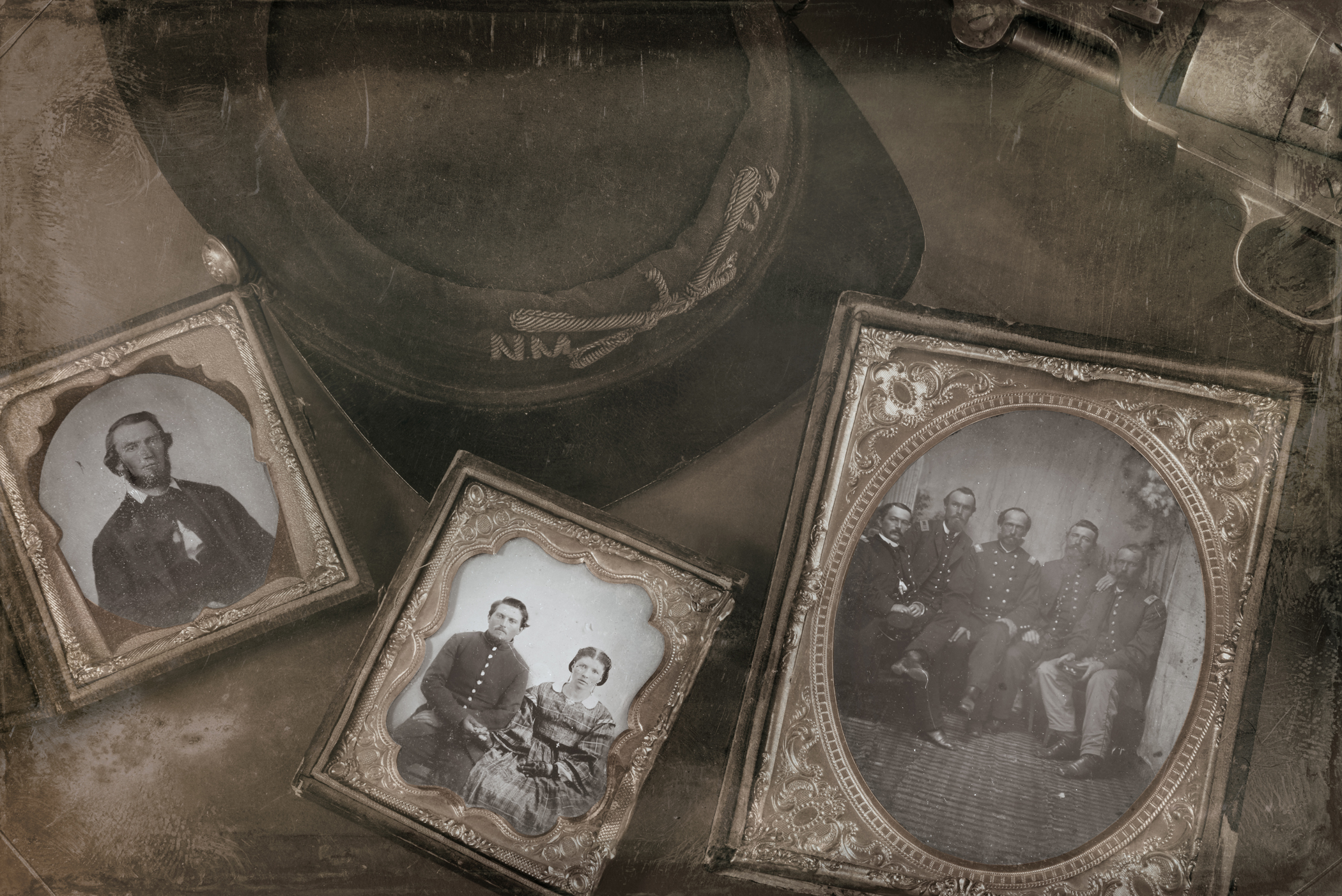
Explore the Civil War in New Mexico
FOR IMMEDIATE RELEASE
April 1, 2015
April 1, 2015
MEDIA CONTACT
Contact not available
Contact not available
Related Photos
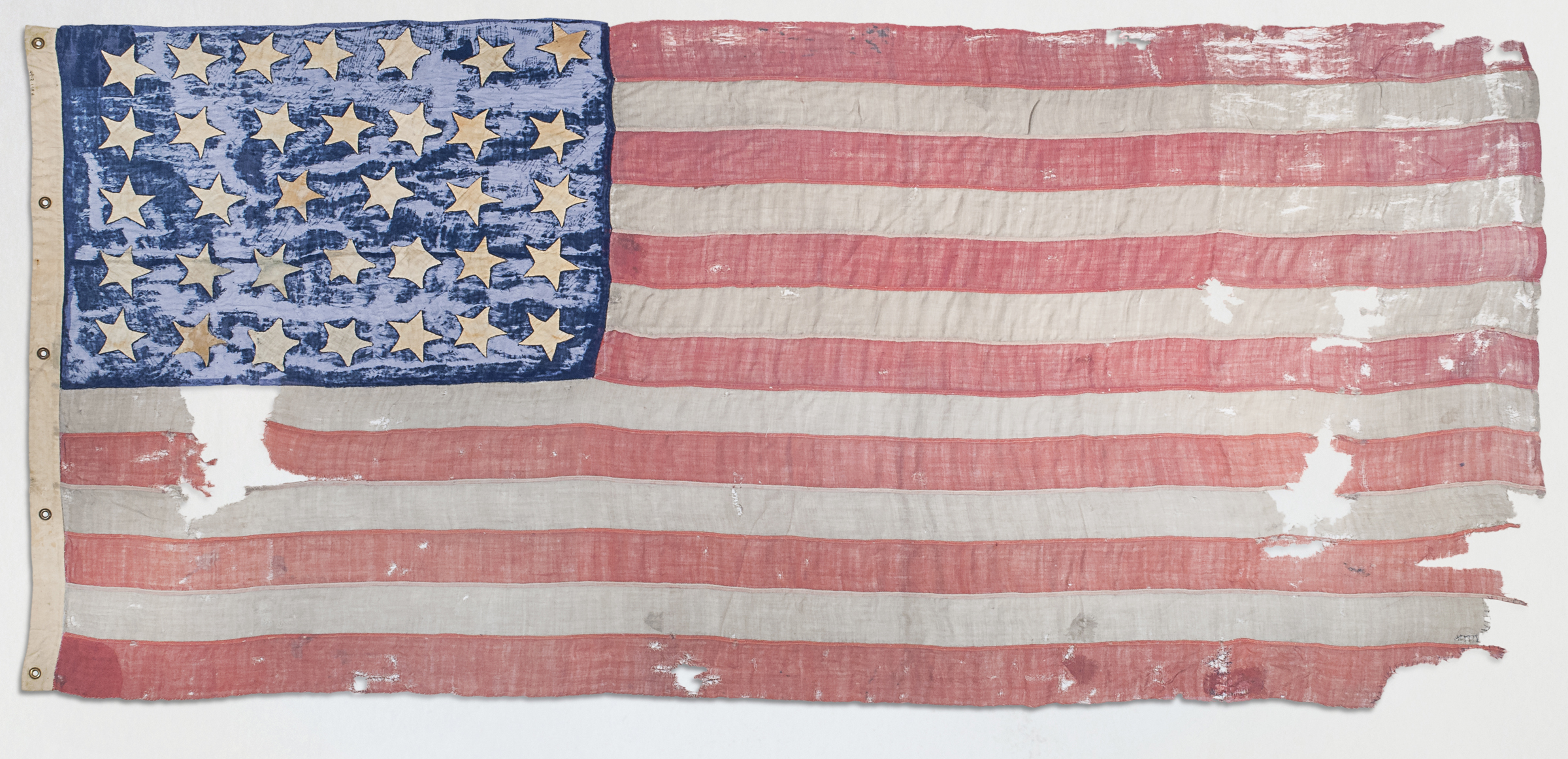
34-Star Union Flag, 1861
Courtesy History Colorado, WR.1104
Photo by Blair Clark
On August 18, 1861, the Ladies of Denver presented this flag to the recently formed First Colorado Infantry, Company D. Each applique star was stitched by hand. The flag and its bearer advanced to New Mexico and served at the Battle of Glorieta. Though beaten and battered, the flag was returned to its home in Colorado. Michael Ivory, one of its color-bearers, held onto the piece, which was later donated to the Colorado Historical Society.
*Note: This image has been flipped. Conservators sewed the flag to its base in the opposite position. We present it this way to reflect how it traditionally would be presented.

Some of the cased images on exhibit, along with a fatigue cap worn by a member of the New Mexico 1st Volunteer Militia, ca. 1860s. New Mexico History Museum Collection and Palace of the Governors Photo Archives. Photo by Blair Clark.
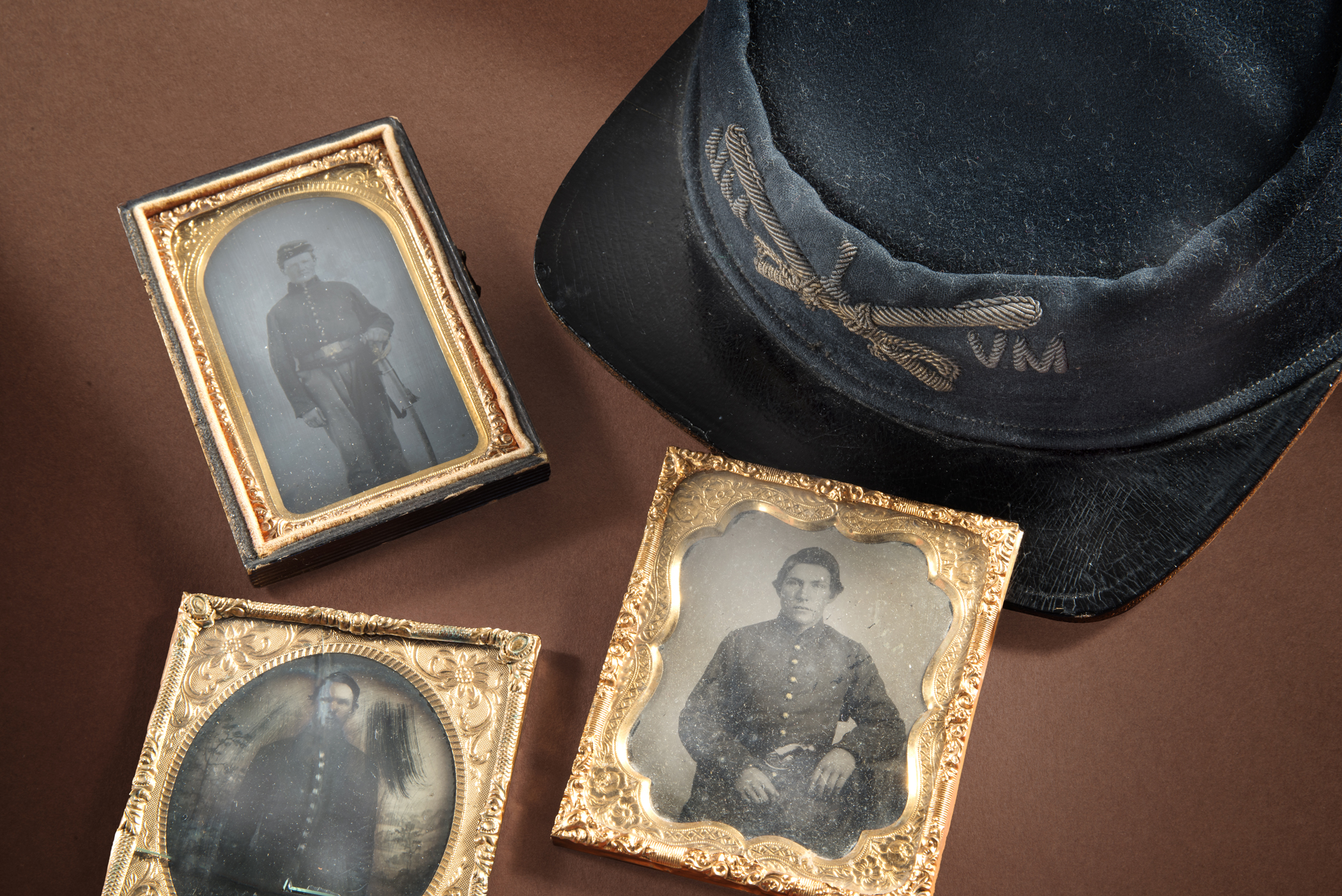
Some of the cased images on exhibit, along with a fatigue cap worn by a member of the New Mexico 1st Volunteer Militia, ca. 1860s. New Mexico History Museum Collection and Palace of the Governors Photo Archives. Photo by Blair Clark.
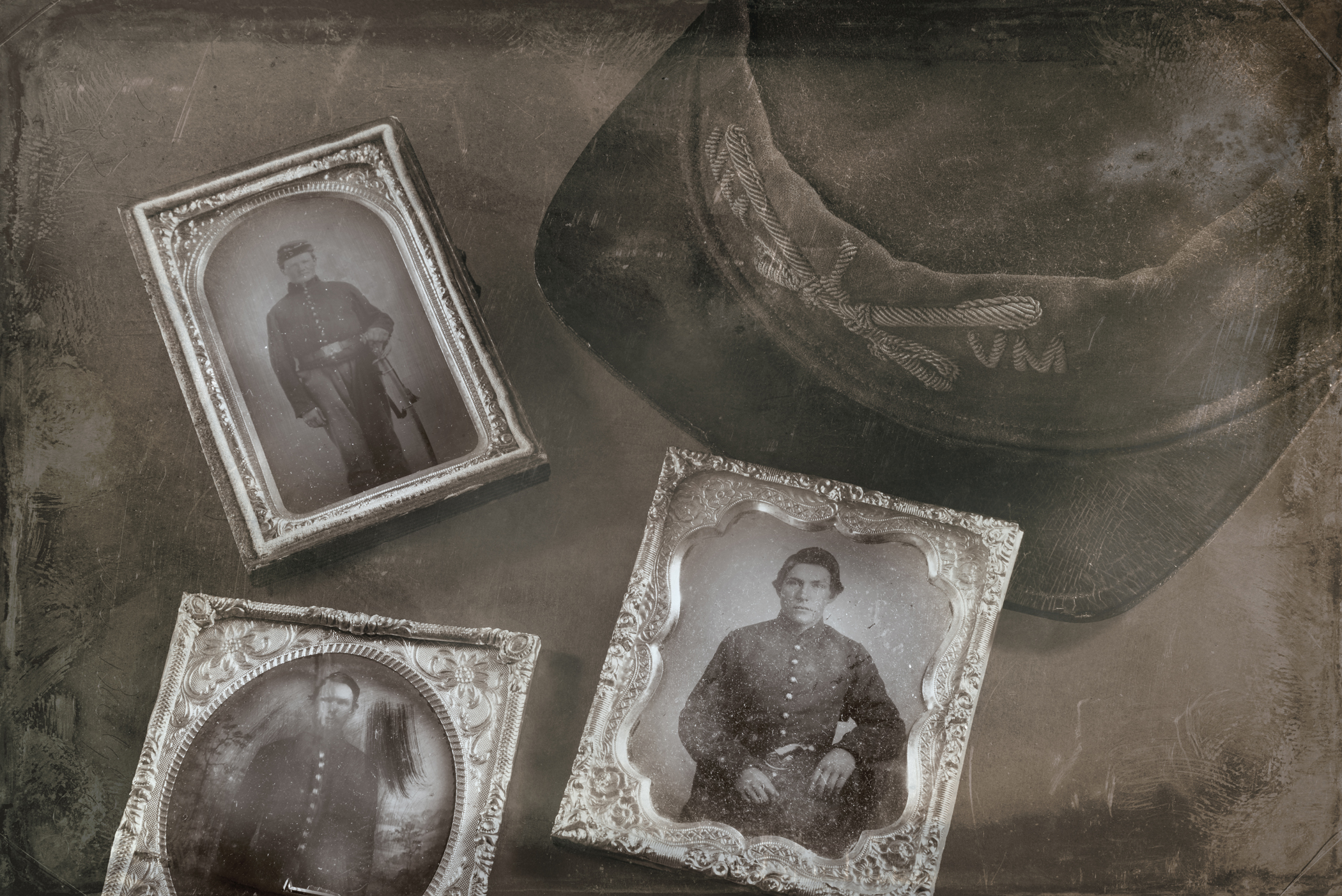
Some of the cased images on exhibit, along with a fatigue cap worn by a member of the New Mexico 1st Volunteer Militia, ca. 1860s. New Mexico History Museum Collection and Palace of the Governors Photo Archives. Photo by Blair Clark.
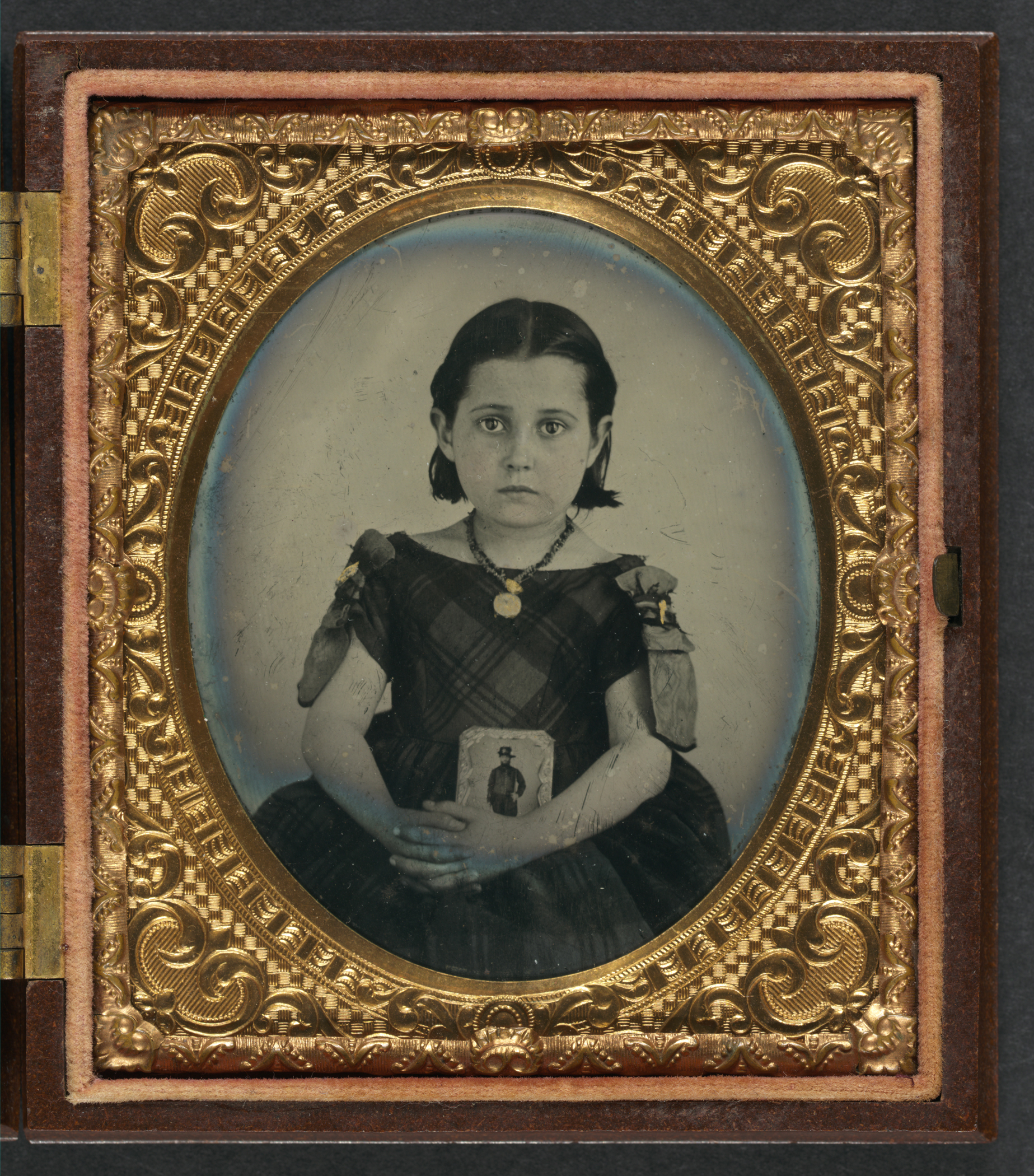
Unidentified girl in mourning dress holding framed photograph of her father as a cavalryman with sword and Hardee hat. Courtesy of the Library of Congress, LC-DIG-ppmsca-36863.
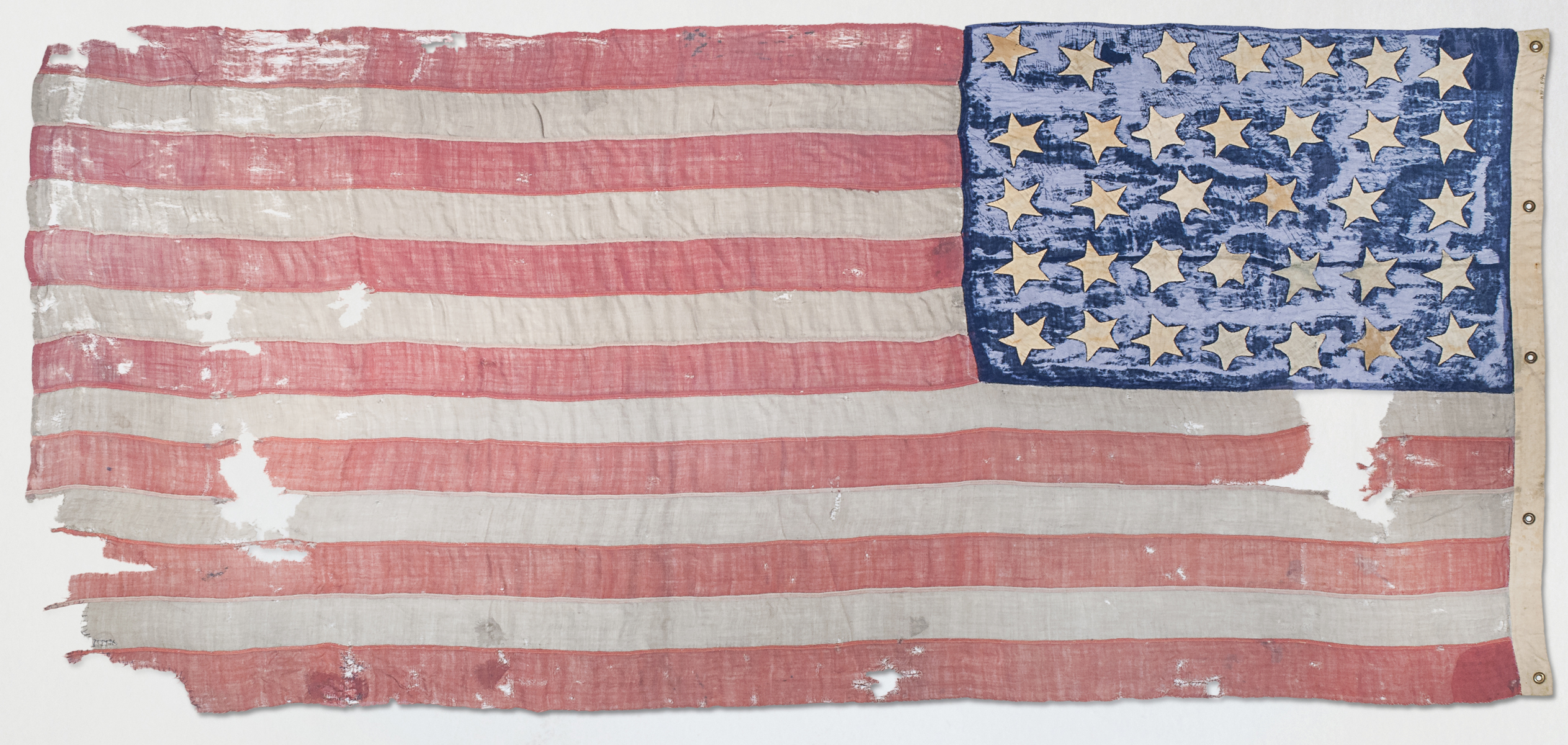
34-Star Union Flag, 1861
Courtesy History Colorado, WR.1104
Photo by Blair Clark
On August 18, 1861, the Ladies of Denver presented this flag to the recently formed First Colorado Infantry, Company D. Each applique star was stitched by hand. The flag and its bearer advanced to New Mexico and served at the Battle of Glorieta. Though beaten and battered, the flag was returned to its home in Colorado. Michael Ivory, one of its color-bearers, held onto the piece, which was later donated to the Colorado Historical Society.
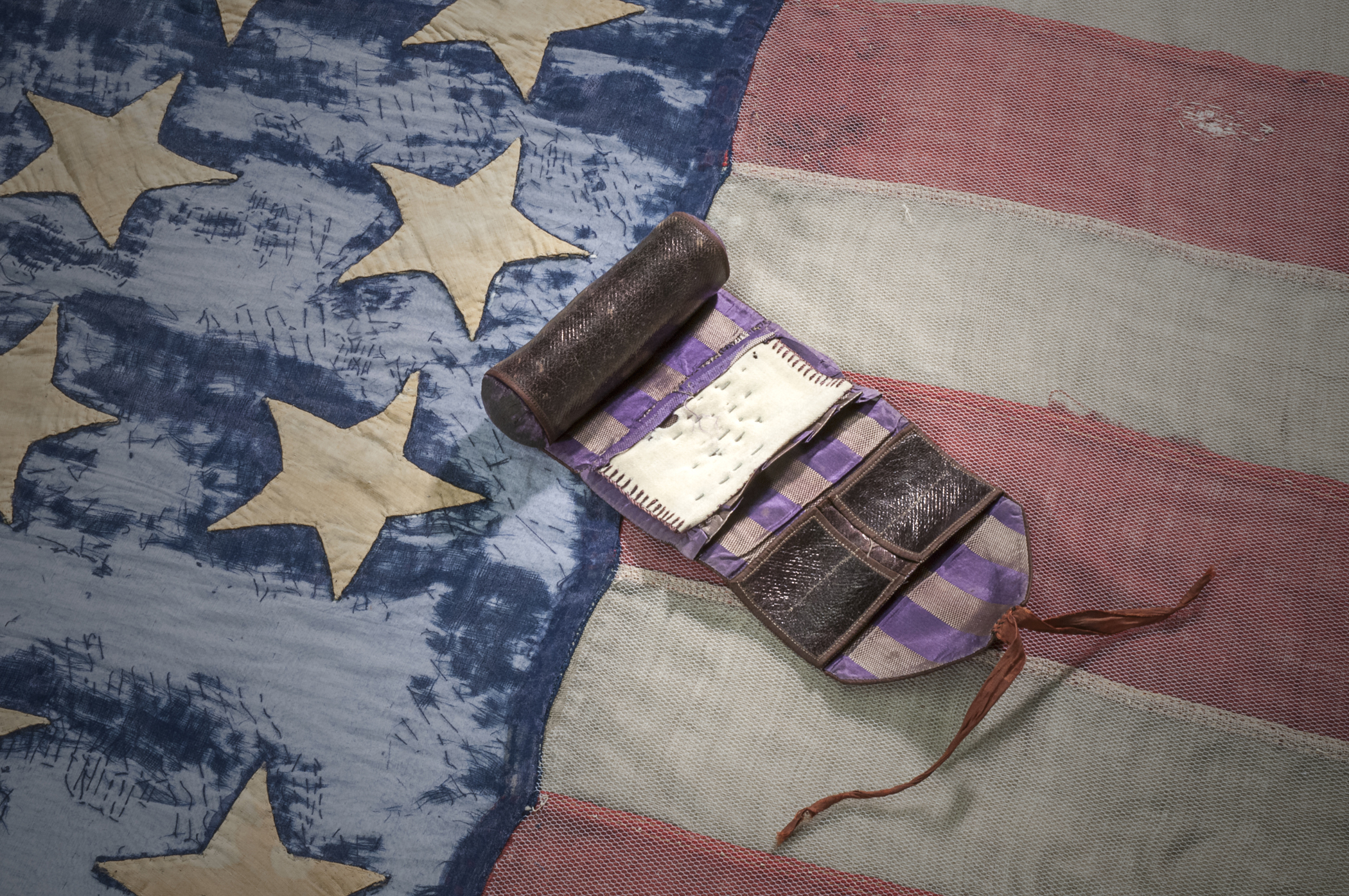
34-Star Union Flag, 1861. Courtesy History Colorado, WR.1104
Civil War-era sewing kit, ca. 1860s. New Mexico History Museum Collection 2543.45
Photo by Blair Clark
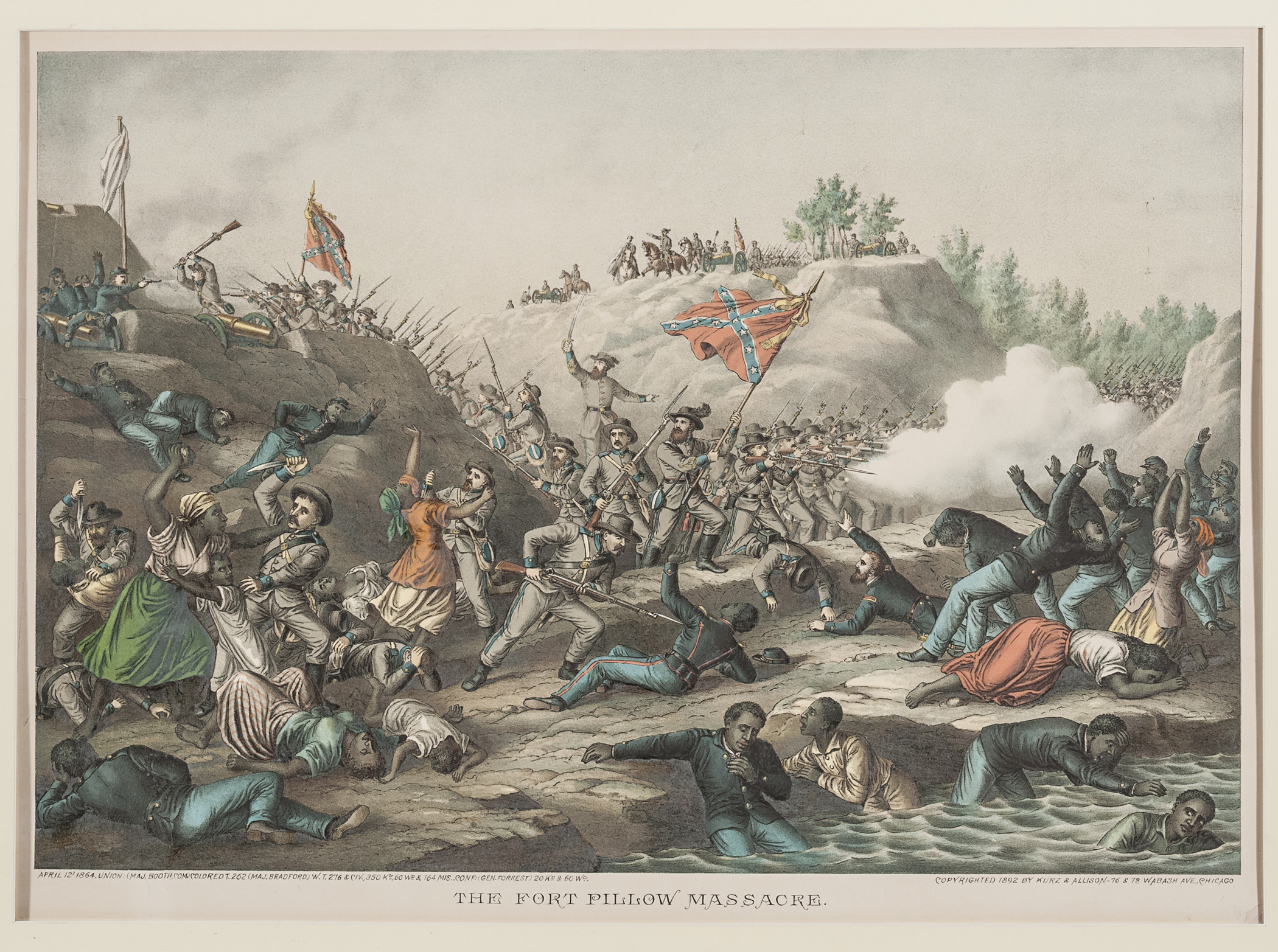
The Fort Pillow Massacre, 1892Chromolithograph, Kurz and AllisonFray Angélico Chávez History Library
On April 12, 1864, the Union-held garrison of Fort Pillow on the Mississippi River in west Tennessee was overrun by Confederate troops. Approximately half of its 500 Union defenders consisted of "colored troops." Though the exact order of events is unclear, the consensus of investigations that followed was that all but 14 of the Black soldiers, along with some of their families, were murdered following their surrender. By the war's end, the massacre was but a footnote in the records of four years of death and destruction. Three decades later, the battle was commemorated in this lithograph published by Kurz and Allison, one of the few firms to portray Black soldiers in any of its scenes.Besides the telling of a disturbing event in the war, this provocative print stands apart from other commemorative lithographs of the post-war period. Rather than supporting the national movement toward reconciliation and the glorification of a common, heroic struggle, nothing in this print suggests anything but tragedy.
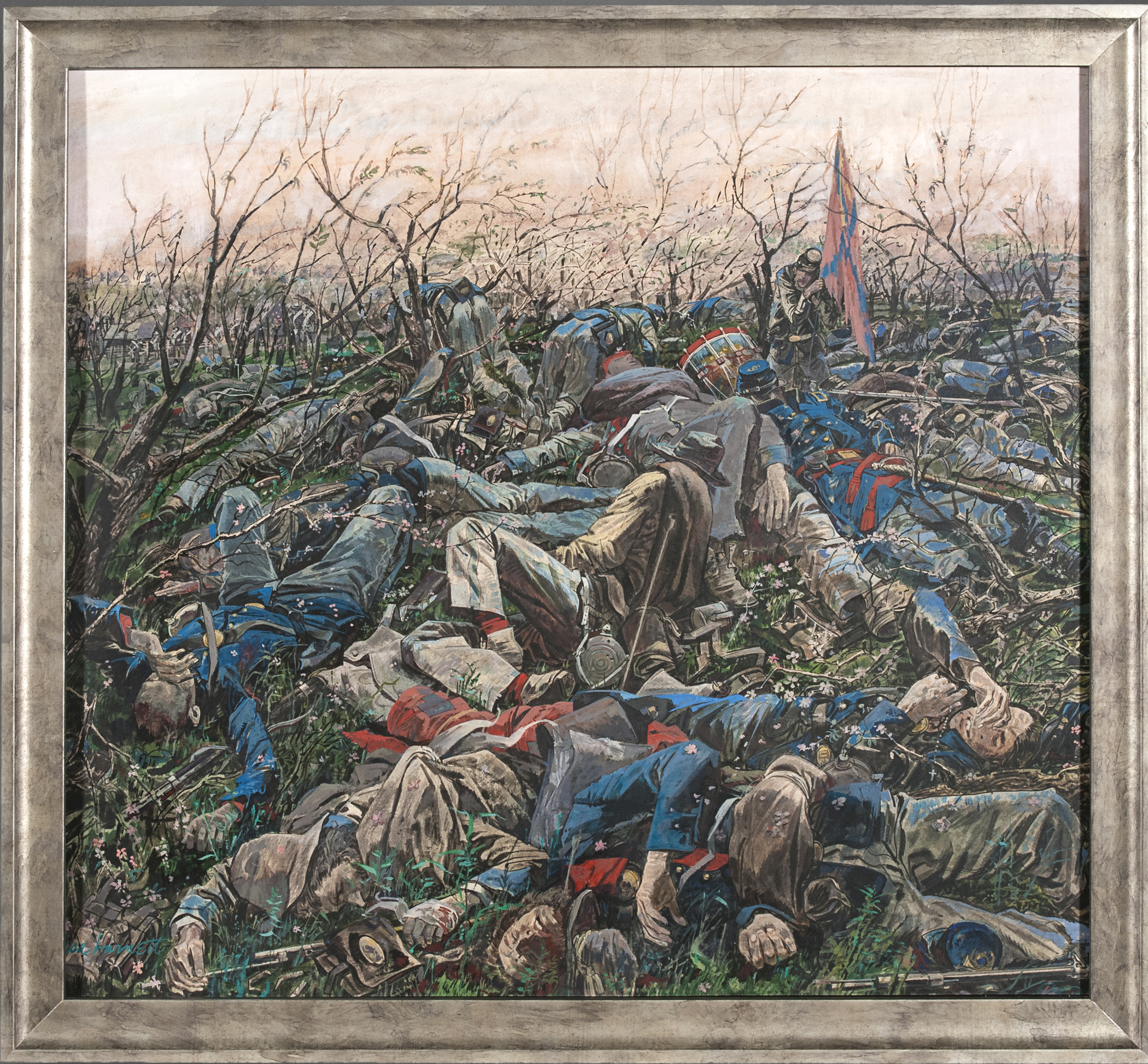
Battle of Shiloh, 1961Isa BarnettCasein on paper Courtesy of Ivan Barnett
With thousands of memorials and annual battle reenactments, remembering the Civil War has become part of our national practice. In 1961, Life Magazine commissioned several artists to reflect upon and represent the most iconic battles for a Civil War Centennial issue. One of those artists was Isa Barnett, an established graphic artist who served in World War II and later lived in Santa Fe. Barnett used photographs and live models and worked closely with historians to ensure that weapons, uniforms, and gestures were authentic for this gritty scene in the Battle of Shiloh. Such illustrations influenced a new generation of Civil War art that flourishes today.
